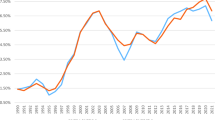Abstract
China is the largest emerging capital market with a unique setup: it issues simultaneously both (i) Class A shares addressed to Chinese domestic investors, and (ii) Class B Shares addressed to foreign investors. After Chinese stock market resumed the operation, they feature dramatic fluctuations due to policy changes and over-speculative activity of individual investors. This paper aims to analyse the evolution of both the Shanghai A and B Markets through a Markov-switching asymmetric GARCH in four different time frames.



Similar content being viewed by others
Notes
Indeed, in most empirical applications, the GARCH(1,1) is enough to reproduce the volatility dynamics of financial data, a fact that led the GARCH(1,1) to become the “workhorse” model by both academics and practitioners (Ardia 2008).
For a complete description of the model see Ardia (2008).
Additionally, \(\pi _1\) and \(\pi _2\) denote the steady state (i.e. long-term probabilities) of the system.
Additionally, and for the sake of robustness, we have fitted two additional models obtaining similar results: Markov Switching Threshold GARCH and a Mixture Markov GARCH.
References
Alexander, C. (2009). Market risk analysis, value at risk models (Vol. 4). Wiley.
Ardia, D. (2008). Financial risk management with Bayesian estimation of GARCH models. Lecture notes in economics and mathematical systems (Vol. 612). Springer.
Ardia, D., Mullen, K. M., Peterson, B. G., & Ulrich, J. (2015). DEoptim: Differential evolution in R. Version 2.2–3.
Bali, T. G. (2007). Modeling the dynamics of interest rate volatility with skewed fat-tailed distributions. Annals of Operations Research, 151(1), 151–178.
Baltagi, B. H., Li, D., & Li, Q. (2006). Transaction tax and stock market behavior: Evidence from an emerging market. Empirical Economics, 31(2), 393–408.
Bollerslev, T. (1986). Generalized autoregressive conditional heteroskedasticity. Journal of Econometrics, 31(3), 307–327.
Chiang, S.-M., Yeh, C.-P., & Chiu, C.-L. (2009). Permanent and transitory components in the chinese stock market: The arji-trend model. Emerging Markets Finance and Trade, 45(3), 35–55.
Chiang, T. C., & Doong, S.-C. (2001). Empirical analysis of stock returns and volatility: Evidence from seven asian stock markets based on tar-garch model. Review of Quantitative Finance and Accounting, 17(3), 301–318.
De Santis, G., & Imrohoroglu, S. (1997). Stock market and volatility in emerging markets. Journal of International Money and Finance, 15(6), 561–579.
Engle, R. F. (1982). Autoregressive conditional heteroscedasticity with estimates of the variance of united kingdom inflation. Econometrica: Journal of the Econometric Society, 50(4), 987–1007.
Engle, R. F., & Ng, V. K. (1993). Measuring and testing the impact of news on volatility. The Journal of Finance, 48(5), 1749–1778.
Fabozzi, F. J., Tunaru, R., Wu, T., et al. (2004). Modeling volatility for the Chinese equity markets. Annals of Economics and Finance, 5, 79–92.
Friedmann, R., & Sanddorf-Köhle, W. G. (2002). Volatility clustering and nontrading days in Chinese stock markets. Journal of Economics and Business, 54(2), 193–217.
Glosten, L., Jagannathan, R., & Runkle, D. (1993). On the relation between the expected value and the volatility of the nominal excess return on stocks. Journal of Finance, 48, 1779–1801.
Haas, M., Mittnik, S., & Paolella, M. S. (2004). A new approach to Markov-switching garch models. Journal of Financial Econometrics, 2(4), 493–530.
Hou, A. J. (2010). Asymmetry effects in Chinese stock markets volatility: A generalized additive nonparametric approach. In Midwest Finance Association conference, February, USA.
Hu, J. (1999). The evolution of China stock market and its institutions. Beijing: Economic Science.
Huang, W.-C., & Zhu, Y. (2004). Are shocks asymmetric to volatility of Chinese stock markets? Review of Pacific Basin Financial Markets and Policies, 7(03), 379–395.
Kang, J., Liu, M.-H., & Ni, S. X. (2002). Contrarian and momentum strategies in the China stock market: 1993–2000. Pacific-Basin Finance Journal, 10(3), 243–265.
Koutmos, G. (1999). Asymmetric price and volatility adjustments in emerging Asian stock markets. Journal of Business Finance and Accounting, 26(1–2), 83–101.
Lee, C. F., Chen, G., & Rui, O. M. (2001). Stock returns and volatility on China’s stock markets. Journal of Financial Research, 24(4), 523–544.
Loudon, G. F. (2006). Is the risk–return relation positive? Further evidence from a stochastic volatility in mean approach. Applied Financial Economics, 16(13), 981–992.
Lu, X. F., Lai, K. K., & Liang, L. (2014). Portfolio value-at-risk estimation in energy futures markets with time-varying copula-garch model. Annals of Operations Research, 219(1), 333–357.
Mandelbrot, B., & Hudson, R. L. (2007). The misbehavior of markets: A fractal view of financial turbulence. Basic Books.
Mookerjee, R., & Yu, Q. (1999). An empirical analysis of the equity markets in China. Review of Financial Economics, 8(1), 41–60.
Mullen, K., Ardia, D., Gil, D., Windover, D., & Cline, J. (2011). DEoptim: An R package for global optimization by differential evolution. Journal of Statistical Software, 40(6), 1–26.
Nelson, D. B. (1991). Conditional heteroskedasticity in asset returns: A new approach. Econometrica: Journal of the Econometric Society, 59(2), 347–370.
Panetta, F., Angelini, P., Grande, G., Levy, A., Perli, R., Yesin, P., Gerlach, S., Ramaswamy, S., & Scatigna, M. (2006). The recent behaviour of financial market volatility. Bank of Italy Occasional Paper (2).
R Core Team (2016). R: A language and environment for statistical computing. R foundation for statistical computing, Vienna, Austria.
Sentana, E. (1995). Quadratic arch models. The Review of Economic Studies, 62(4), 639–661.
Wang, S. S., & Jiang, L. (2004). Location of trade, ownership restrictions, and market illiquidity: Examining Chinese a-and h-shares. Journal of Banking and Finance, 28(6), 1273–1297.
Zakoian, J.-M. (1994). Threshold heteroskedastic models. Journal of Economic Dynamics and Control, 18(5), 931–955.
Acknowledgements
The usual caveat applies. We are particularly grateful to two anonymous referees and the Editor-in-Chief for many valuable comments and suggestions that have led to a substantial improvement in the manuscript. Financial support from Generalitat de Catalunya (2014SGR325 and 2014SGR631) and Ministerio de Economía y Competitividad (ECO2016-75410-P) is acknowledged.
Author information
Authors and Affiliations
Corresponding author
Electronic supplementary material
Below is the link to the electronic supplementary material.
Rights and permissions
About this article
Cite this article
Cano-Berlanga, S., Giménez-Gómez, JM. On Chinese stock markets: How have they evolved over time?. Ann Oper Res 266, 499–510 (2018). https://doi.org/10.1007/s10479-017-2602-4
Published:
Issue Date:
DOI: https://doi.org/10.1007/s10479-017-2602-4




